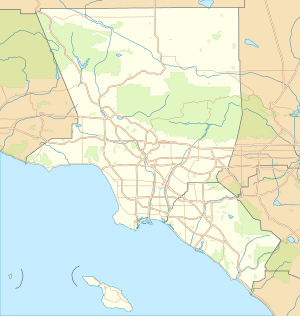Miller and Herriott House
|
Miller and Herriott House | |
|
Miller and Herriott House, 2008 | |
   | |
| Location | 1163 W. 27th Street, North University Park, Los Angeles, California, 90007 |
|---|---|
| Coordinates | 34°1′50″N 118°17′7″W / 34.03056°N 118.28528°WCoordinates: 34°1′50″N 118°17′7″W / 34.03056°N 118.28528°W |
| Built | 1890 |
| Architect | Unknown |
| Architectural style | Queen Anne-Stick-Eastlake |
| NRHP Reference # | 79000486[1] |
| LAHCM # | 242 |
| Significant dates | |
| Added to NRHP | November 16, 1979 |
| Designated LAHCM | April 9, 1981[2] |
The Miller and Herriott House, also known as the Miller and Herriott Tract House, is a historic Victorian house in the North University Park section of Los Angeles, California. Built in 1890, the house is considered to be a combination of Stick and Eastlake styles. The identity of the architect is not known, though some have attributed the design to Joseph Cather Newsom.[3] A short distance from the University of Southern California campus, the house is now used primarily for student housing.
History
The house was built as part of the Harper Tract developed by Miller & Herriott. In 1888, the two developers bought a 25-acre (100,000 m2) piece of land west of Hoover Street, between the prestigious West Adams district to the north and the nascent University of Southern California to the south. They subdivided the land into 98 lots, building "substantial and tasty residences, costing not less than $3000 each."[4] Considered a "suburb" at the time, the Los Angeles Times correctly predicted: "The whole city is growing rapidly to the southwest, and it will not be long before it will be a misnomer to call that section a suburb."[5] The Miller and Herriott House is the oldest surviving structure in the Harper Tract.[3]
By 1980, the house had gone through 27 owners.[6] It was restored in the early 1980s, though the original stained glass in the front door transom was removed for use in a restaurant near Disneyland.[7] After touring the house in 1980, Los Angeles Times columnist Jack Smith called it "tall and lacy, with a plush, ornate and comfortably cluttered interior in Victorian style."[6] Commenting on the removal of the stained glass to an Orange County restaurant, Smith noted: "There was new glass in its place, but it looked like that wooden leg must have looked on Sara Bernhardt."[6]
Landmark
The house was listed on the National Register of Historic Places in 1979 and designated as a Historic Cultural Monument (HCM #242) by the Los Angeles Cultural Heritage Commission in 1981.[8] It is also part of the North University Park Historic District.
See also
- List of Registered Historic Places in Los Angeles
- List of Los Angeles Historic-Cultural Monuments in South Los Angeles
References
- ↑ National Park Service (2008-04-15). "National Register Information System". National Register of Historic Places. National Park Service.
- ↑ Department of City Planning. "Designated Historic-Cultural Monuments". City of Los Angeles. Retrieved 2010-06-15.
- 1 2 "On tour". Los Angeles Times, p. H2. 1981-09-13.
- ↑ "The Harper Tract: A Suburb That Has Had no Reaction". Los Angeles Times. 1891-07-12.
- ↑ "The Harper Tract". Los Angeles Times. 1891-07-17.
- 1 2 3 Jack Smith (1980-09-16). "House-to-House Resuscitation". Los Angeles Times.
- ↑ Alan Parachini (1980-09-14). "Gentrification of Los Angeles: A Return to Urban Living?". Los Angeles Times.
- ↑ "Historic-Cultural Monuments Listing" (PDF). City of Los Angeles. 2008-06-04.
External links
| Wikimedia Commons has media related to Miller and Herriott House. |